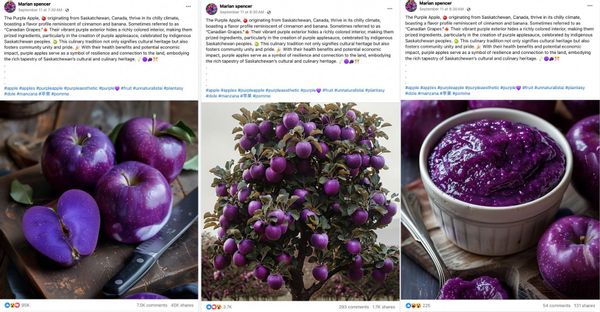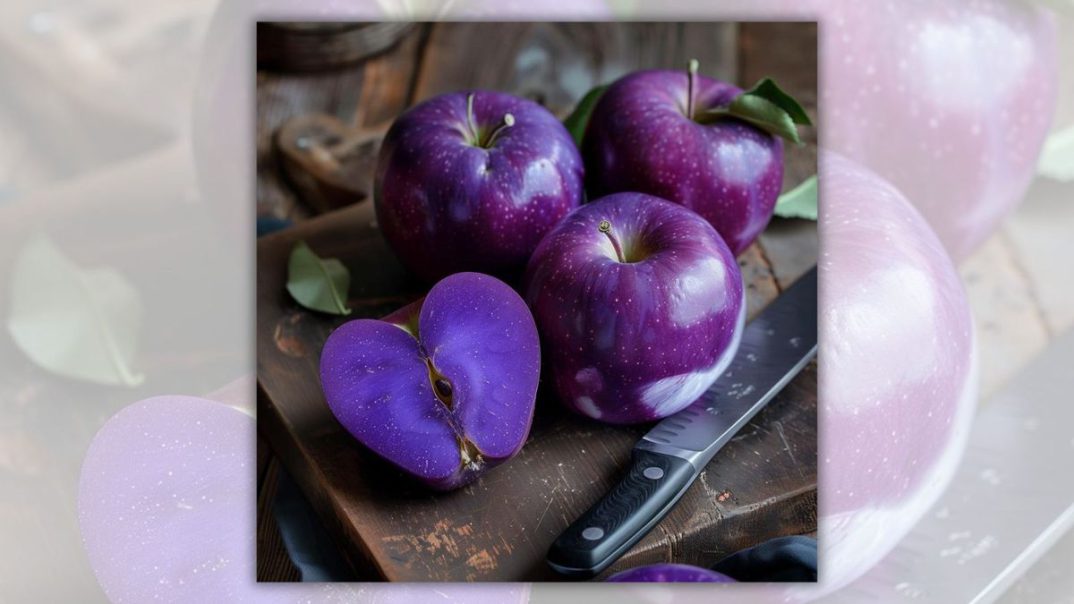Claim:
A photo shared on social media authentically showed purple apples grown in the Canadian province of Saskatchewan.
Rating:
On Sept. 15, 2024, readers questioned the veracity of a photo being shared online that showed a group of purple apples on a cutting board. One of the fruits was cut in half, revealing the flesh to also be bright purple.
The image was part of a Facebook post (archived) from Sept. 11, 2024, by a user named Marian spencer. The caption of the post stated:
The Purple Apple, originating from Saskatchewan, Canada, thrive in its chilly climate, boasting a flavor profile reminiscent of cinnamon and banana. Sometimes referred to as “Canadian Grapes.” Their vibrant purple exterior hides a richly colored interior, making them prized ingredients, particularly in the creation of purple applesauce, celebrated by indigenous Saskatchewan peoples. This culinary tradition not only signifies cultural heritage but also fosters community unity and pride. With their health benefits and potential economic impact, purple apples serve as a symbol of resilience and connection to the land, embodying the rich tapestry of Saskatchewan’s cultural and culinary heritage.
As of this writing, the post had amassed more than 100,000 reactions, 47,000 shares and 7,900 comments, many of them doubting the authenticity of the picture and caption.
For example, one commenter on the Facebook post wrote, “I am from Canada, driven all across it in the apple season; and I promise we ain’t got these apples.” Another said: “The fact that they’re lying about not just the apple but the cultural signifigance and stuff too is not only stupid, I’d also say its offensive.”
These users were right to be skeptical, as there was no evidence to support the existence of apples with both purple skin and purple flesh, in Saskatchewan or elsewhere. Additionally, the owner of the Marian spencer account confirmed the images were produced using AI software. It’s for these reasons we rated this image as a fake.
The Sept. 11 post was not the only photograph of purple apples posted by the Marian spencer account. Later the same day, the same user posted two additional photos with the same caption. One showed (archived) a tree laden with purple apples, while the other showed (archived) purple apples surrounding a bowl of what appeared to be purple applesauce:

(Facebook account Marian spencer)
Reverse image searches conducted using Google Images and TinEye found that none of the three photos appeared elsewhere online prior to the three Marian spencer posts, suggesting the account’s owner was the first to upload the pictures to the internet.
Over Facebook Messenger, the owner of the Marian spencer account said: “Yes, I’m using AI,” and further clarified the purple apple images were “FULL 100% AI.” The account owner also expressed regret that they did not more explicitly label the images as AI art.
However, a series of hashtags included at the bottom of each post did contain clues the images were generated by AI, rather than being authentic photos of real fruit. The full list of hashtags was:
#apple #apples #purpleapple #purpleaesthetic #purple💜 #fruit #unnaturalistai #plantasy #dole #manzana #苹果 #pomme
Two of those hashtags, #unnaturalistai and #plantasy — a portmanteau of “plant” and “fantasy” — acknowledged the images were not real.
Additionally, since the beginning of September 2024, the user’s posted photos have consisted almost entirely of unreal-looking images of plants and fungi, including a transparent cactus, rainbow mushrooms and a flower bud bearing the Louis Vuitton logo. Many of these images were also tagged with the #unnaturalistai and #plantasy hashtags.
Beyond the authenticity of the photos themselves, there was no evidence to support the posts’ claims that purple apples grew in Saskatchewan or represented any aspect of the province’s “cultural and culinary history.”
In an email, Kim McKenzie, the owner of Symmetree Orchard in Luseland, Saskatchewan, said the posts’ claims about purple apples in the province were “false,” explaining: “We can grow apples in Saskatchewan but…definitely no purple ones.”
Purple apples do exist elsewhere in the world, but none of these matched the apples shown in the images. For example, Black Diamond apples have skin that is a purple so deep it can be mistaken for black. Purple Bravo apples have skin that is reddish-purple or burgundy. Critically, Black Diamond and Purple Bravo apples both have flesh that is white — not purple — underneath their skin.
Another fruit sometimes referred to as a purple apple is not a true apple at all. More commonly known as the star apple or caimito, that fruit is produced by a tree in the Chrysophyllum genus. True apples, by contrast, are members of the Malus genus.
The star apple, furthermore, presents some notable differences in appearance from the fruit shown in the image investigated here. First, it is spherical, lacking the indentations that give true apples their characteristic heart shape when halved. Second, while their inner flesh or pulp can be purple in color, star apples contain a large, star-shaped cluster of seed cells at their center.
Despite some superficial similarities to the apples shown in the images, none of these purple fruits is known to grow in Saskatchewan. Black Diamond apples are grown in Tibet, while Purple Bravo apples are grown in Australia. Star apples, native to Central America and the Caribbean, are now grown in many parts of the world, including Australia and some regions of Southeast Asia and Africa — but there were no reports of the plant being cultivated in Canada.
In summary, because the Facebook images of the purple apples were described as “FULL 100% AI” by their creator, and because there was no evidence to support the posts’ claims that purple apples are grown in Saskatchewan, we have rated this claim as fake.





